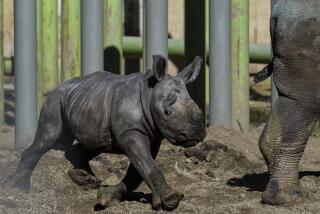S. Africa Sells Wildlife in Name of Conservation : Wildlife: Hundreds of giraffes, zebras and antelope also are sold, some to hunting ranches in search of trophies. Others go to breeders who hope the animals will go forth and multiply.
- Share via
HLUHLUWE, South Africa — Bigger than cars and rare as Picassos, 70 white and black rhinos were on the auction block--some destined to be killed by foreign hunters who pay for the privilege.
Auctioneer Dallas Kemp wore a cowboy hat as he called out prices in South African rands under the crowded circus tent. Around him, tense buyers punched calculators.
“Seventy thousand, I got 70,000, 70,000 now,” Kemp chanted, his eye fixed on a bidder in the 12th row. “I’m bringing the hammer down on 70,000. The hammer’s going down . . . Sold!”
Gary Kelly, owner of a hunting ranch, had just spent the equivalent of $20,000 on a one-ton white bull rhinoceros caught weeks earlier by the Natal Parks Board using a helicopter and a tranquilizer dart.
The auction July 1, which also sold hundreds of giraffes, zebras and antelope for a total of $1.4 million, was a glimpse of a future where conservationists say Africa’s wildlife will have to pay its way to survive.
About 15% of the rhinos, but none of the rare black variety, were sold to be hunted. Kelly paid $31,000 for two more rhinos, sight unseen but guaranteed to carry trophy-length horns at least 22 inches long.
The proceeds will pay to maintain the board’s game reserves. They are some of the world’s best, but under pressure as President Nelson Mandela scours the public purse to pay for housing and education.
“Wildlife has got to hold its own place in South Africa today along with everything else,” said George Hughes, the board’s chief executive. “If wildlife can pay for itself, it has a better chance of staying.”
Kelly makes it pay off by offering targets to wealthy foreigners--often Americans, Germans or Mexicans--who will pay more than $30,000 to bag a rhino on his ranch.
To fetch the best price, the horns must not be too curved, straight or short.
“If I buy a rhino, I buy him as a trophy,” said rancher Chris Bothma. “I look at him the same way a sheep farmer looks at sheep.”
Selling a rare animal to be shot may seem an odd form of conservation, but South Africa’s professional conservationists show no embarrassment.
Excess animals have to be removed from parks to protect limited resources, they say. And selling an old specimen to a hunter raises money for other animals to live.
Most of the rhinos sold at the annual auction, however, will avoid the bullet and instead go to private breeders, zoos and safari parks eager to build up their own herds for sale or to attract tourists.
The parks board contends making wildlife a viable commodity helps it survive relentless poaching and land-hungry humans. That includes treating wildlife management like a business and nurturing new programs aimed at discouraging poachers by making wildlife parks profitable to surrounding communities.
“The system works--success is on their side,” said John Hanks, South African director of the World Wide Fund for Nature. “Sixty-three percent of the rhinos in the world today are in South Africa.”
The Natal Parks Board manages the oldest game reserves in Africa, founded a century ago when only 14 white rhinos survived. Since then, the number has risen to 7,000 worldwide, all descendants of that herd.
The board began auctioning rhinos in 1989. It wanted to reduce overgrazing, spread out the animals so that a local epidemic could not wipe out the species, and supplement its government funds.
But without South Africa’s strict controls on hunting and trading, the system might not work in other African nations whose wildlife are on the verge of extinction, World Wide Fund for Nature officials say.
The parks board wants to bring one species back from the brink: the black rhino, which once roamed huge areas of eastern and southern Africa.
In recent years, poachers and smugglers, aided by corrupt officials, have sold rhino horn to the Middle East for dagger handles and to Asia for traditional medicine--not for aphrodisiacs, Hughes said, but powders to combat fevers.
From a population of 150,000 black rhinos at the turn of the century, only 3,000 are left worldwide--a third of them in South Africa.
The most fevered bidding at the July 1 auction was for six black rhinos, a breeding herd sold in one lot.
Television cameras surrounded the four approved bidders as they sweated their way through the soaring offers, slowly dropping out until Kemp, the auctioneer, brought his hammer down at 140,000 rand, or $40,000, per animal.
That brought the bill to $240,000 for Rhino Land Safaris, a breeding outfit buying its first black rhinos. Unlike the white rhinos, they cannot be resold or hunted.
The spread of breeding herds to firms like Rhino Land Safaris will eventually mean more animals and lower auction prices, said Hughes, the parks board director.
That is good news for Mpusowa Bathethwu, chief of several thousand Zulus living near Hluhluwe. They want to develop a 50,000-acre game park to draw tourists and create jobs.
“Game has much more value than cattle,” said Bathethwu. “Using game to help the people is very positive. Before, the parks never brought us anything. Now, maybe they will.”
More to Read
Sign up for Essential California
The most important California stories and recommendations in your inbox every morning.
You may occasionally receive promotional content from the Los Angeles Times.










